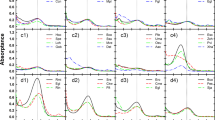Abstract
Forty-six polygonaceous plants were examined regarding the nature and amount of anthocyanidins which were obtained as the HCl-hydrolyzate of leaf proanthocyanidins. All of the plants examined contained cyanidin in common in their hydrolyzed leafextracts. From this survey, at least three groups of plants may be distinguished; the first containing only cyanidin, the second delphinidin in addition to cyanidin and the third an unknown anthocyanidin (called PA-X) and cyanidin. Of the plants examined,Polygonum cuspidatum leaves yielded cyanidin in the largest amounf. There were no geographical and seasondl variations of the distribution pattern of pigments in the plants, and also no variation of anthocyanidin-types was observed in young and mature leaves.
A further survey of anthocyanins in the plants revealed that delphinidin glycosides are present in the sepals ofPolygonum nepalense andP. thunbergii.
Similar content being viewed by others
References
Bate-Smith, E.C. 1961. The phenolic constituents of plants and their taxonomic significance I. Dicotyledons. J. Linn. Soc. (Bot.)58: 95–173.
Fourie, T.G., D. Ferreira andD.G. Roux. 1974. 8-O-methyl- and the first 3-O-methylflavan-3, 4-diols fromAcania saxatilis. Phytochemistry13: 2573–2587.
Haraldson, K. 1978. Anatomy and taxonomy in Polygonaceae subfam. Polygonoideae Meisn. emend Jaretzky. Symb. Bot. Upsal.22: 1–95.
Harborne, J.B. 1967. Comparative Biochemistry of the Flavonoids. Academic Press, London.
— 1977. Flavonoids and the evolution of the Angiosperms. Biochem. System. Ecol.5: 7–22.
Kawasaki, M., T. Kanomata andK. Yoshitama. 1986. Flavonoids in the leaves of twentyeight polygonaceous plants. Bot. Mag. Tokyo99: 63–74.
Kitamura, S. andG. Murata. 1961. Coloured Illustrations of Herbaceous Plants of Japan Vol. II. Hikusha, Osaka (in Japanese).
Nonaka, G., I. Nishioka, T. Nagasawa andH. Oura. 1981. Tannins and related compounds. I. Rhubarb (1). Chem. Pharm. Bull.29: 2862–2870.
—. 1982. Stilbene glycoside gallates and proanthocyanidins fromPolygonum multiflorum. Phytochemistry21: 429–432.
Sporne, K.R. 1969. The ovule as an indicator of evolutionary status in Angiosperms. New Phytol.68: 555–566.
Yoshitama, K., M. Hisada andN. Ishikura. 1984. Distribution pattern of anthocyanins in the Polygonaceae. Bot. Mag. Tokyo97: 31–38.
Author information
Authors and Affiliations
Rights and permissions
About this article
Cite this article
Yoshitama, K., Nishino, H., Ozawa, H. et al. Distribution pattern of anthocyanidins and anthocyanins in polygonaceous plants. Bot. Mag. Tokyo 100, 143–149 (1987). https://doi.org/10.1007/BF02488319
Received:
Accepted:
Issue Date:
DOI: https://doi.org/10.1007/BF02488319




